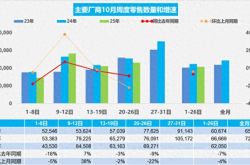Chinese Enterprises' New Era of Overseas Expansion: AI as the "Game Changer"
![]() 08/06 2025
08/06 2025
![]() 461
461

In 2023, AI was an experimental product for Chinese enterprises venturing overseas. By 2024, it had evolved into an efficiency booster. Now, in 2025, AI has firmly grasped the reins of real production processes, transcending mere tool status and entering the realm of systematic integration. This marks a significant leap for overseas enterprises, with pioneers paving the way into the "overseas expansion 2.0" era.
Author|DouDou
Editor|PiYe
Produced by|Industry Home
"Domineering CEO Short Drama" rakes in 500 million yuan in monthly recharges; Jiangsu's Donghai County contributes nearly 10% of the global crystal market from a single county; BYD surpasses Tesla in sales across 14 European countries, selling over 10,000 units per month... In 2025, the "overseas expansion narratives" of Chinese enterprises have embarked on a new chapter.
Behind this collective highlight, there lies a subtle yet potent force driving these advancements.
According to RDI statistics, global AI application overseas visits surpassed 7.6 billion in 2025, with Chinese enterprises accounting for approximately 50%. Chinese AI is demonstrating unparalleled penetration power in the international market.
Unlike previous years, this round of overseas expansion isn't merely about enterprises "using AI to go overseas"; increasingly, Chinese AI companies are themselves "going overseas".
AI is no longer just an efficiency tool inserted into a specific link but rather the backbone spanning the entire chain—from content production to product distribution, customer service management, and user operations.
AI technology providers have evolved beyond being mere "API interface providers." They actively seek landing scenarios and establish ecological networks in the global market, aiming to transform their technologies and products into the "digital infrastructure" for global SMEs.
This shift signifies a structural transformation.
I. AI: From "Assisting in Going Overseas" to "Taking You Overseas"
"In 2025, we started doing cross-border e-commerce ourselves." These words come from the founder of a cross-border e-commerce technology service provider. In his view, AI has vastly expanded the boundaries of overseas expansion, enabling more service providers, previously mere assistants, to venture into business operations independently.
A more tangible change lies in the enhancement of human efficiency.
When Li Ying (pseudonym) first delved into cross-border e-commerce, she was a customer service representative reliant on a translator. Now, with the aid of AI assistants, she independently manages multiple cross-border stores.
"I never imagined before that one person could handle so many roles—graphic design, operations, advertising, and customer service," Li Ying said with emotion.
She is not alone. In 2025, AI has lowered the skill threshold for overseas expansion and amplified individual execution capabilities, making "one person going overseas" increasingly feasible.
This transformation is particularly evident in the case of Devans Technology.
Founder Liu Shiqi revealed in a media interview that their five-person team can accomplish the work of over a dozen people, thanks to their self-developed AI system. The system comprises four "assistants," each responsible for operation optimization, content generation, customer reception, and risk control and warning. Each link is modularized and streamlined, significantly boosting execution efficiency.
Take short video content as an example. In the past, only large teams and companies with substantial budgets could produce it. Now, AI tools have democratized this field. With a script and product images, localized videos tailored to TikTok's preferences can be generated with a single click. The system automatically adds local voiceovers and subtitles, even editing out overly long intros for different markets to highlight key points.
Data shows that they once used AI to batch generate over 30 promotional short videos for Indonesia, automatically optimizing distribution based on click-through rates and improving ROI by nearly 40%.
In the time-consuming customer service domain, AI is also taking over comprehensively.
"Our AI outbound call platform can independently complete the entire process from lead screening to intention confirmation," Zhang Lei (pseudonym), the relevant person in charge of an outbound call technology service provider, told Industry Home.
The operational end is also being demanned.
Huang Xuefeng, the founder of Yichu Technology, mentioned in a media interview that in their early days, they relied on manual uploads of product links, costing about 5 yuan per link. Now, by leveraging the RPA process, each link costs only 0.02 yuan, with efficiency increased by over a hundred times. Behind this is their self-developed advertising data scraping robot + Feishu workflow, automatically pushing optimal advertising suggestions. Operation personnel only need to make judgments, with AI handling the rest.
In his view, this not only enhances efficiency but, more importantly, truly liberates people from manual operations.
AI is reconstructing not just efficiency or tool integration but the overall organizational logic of overseas enterprises. Previously fragmented links are becoming more integrated and systematic, with processes evolving from "trial and error" to "systematic".
Simultaneously, Chinese AI companies are also expanding overseas.
For instance, liblibAI, China's first AI multimodal community, has evolved from raw images to a content platform with over a billion users, with global user visits now exceeding 100 million. Shengshu Technology's video generation application Vidu has covered more than 200 countries and regions.
Behind this lies a "mutually reinforcing scenarios" resonance, where overseas enterprises need AI to address content, marketing, and customer service challenges, while AI vendors require real customers and local feedback to train and optimize their systems.
This two-way demand is rapidly accelerating the penetration of AI. Data from Alibaba's international wholesale platform shows that among approximately 200,000 merchants, over 50% use AI tools weekly, and the company aims to achieve 100% AI coverage for merchants by year-end.
If in the past, AI was merely an auxiliary tool for overseas expansion, in 2025, it is steering the ship. AI is no longer just assisting but is actively driving the overseas expansion journey.
II. All Capabilities Gradually "Meeting the Standard," Entering the "Comfort Zone"
The fact that AI can truly become the "main engine" for Chinese enterprises' overseas expansion in 2025 is not fortuitous but the culmination of several key milestones simultaneously meeting the standard.
A few years ago, many AI products appeared high-end but remained in the PPT and Demo stages. Text generation was prone to nonsense, speech synthesis was unnatural, video quality was unusable, and deployment was difficult with complex system access. Enterprises' trust in AI mostly hovered around "it's okay to understand, but don't take it too seriously".
While model capabilities improved in 2024, the high usage cost became a new hurdle. AI was accessible but unaffordable, let alone deeply integrated into business operations.
But 2025 is a game-changer.
With the leap in multimodal large model capabilities, AI has evolved from an auxiliary tool to a leading capability. The generation quality of images, text, speech, and video has reached commercial usability standards, semantic understanding is robust, support for over a hundred languages is provided, and cultural adaptation is more natural.
"Our operation assistant can now automatically generate the overall schedule for marketing activities and draft copy based on site rhythms, holidays, and new product launches. In the past, these tasks would take an operations team several days, but now they can be completed in one to two hours," Liu Shiqi said in a media interview.
The significant drop in AI usage cost has also lowered the adoption threshold, allowing AI to no longer just assist with tasks but to optimize the entire business process.
"Every call and every customer interaction is quantifiable. AI can recognize customer intentions, judge resistance signals, and automatically adjust scripts," said Zhang Lei. This is not replacing humans but making the system smarter and more efficient.
The explosion of AI in the overseas expansion race is not just due to technological maturity but also because demand is pouring in rapidly.
A notable fact is that in recent years, not only Chinese enterprises want to expand overseas but global SMEs have also started proactively seeking them out, especially in lower-tier overseas markets.
Currently, the demand for content marketing, automated customer service, and multilingual localization from SMEs in Southeast Asia, the Middle East, Latin America, and other regions is rapidly rising. The combination of platform e-commerce (such as TikTok Shop, Shopee) + social media distribution + local payment + fast logistics has enabled them to shift from product selling to brand operation, precisely where AI can provide maximum value.
Data shows this trend is accelerating. According to a report by global e-commerce research institution Digital Commerce 360, 42% of cross-border e-commerce sellers in Indonesia and Vietnam have already adopted AI, while the figures for Singapore and Thailand are 39%. AI is becoming a standard tool for an increasing number of merchants in these markets.
It's worth noting that in this process, Chinese technology service providers are gradually taking the initiative.
"Many customers originally lacked a complete process concept, and we directly provided them with an 'AI system like an assembly line,' which greatly surprised them," Huang Xuefeng mentioned in a media interview.
In fact, Chinese AI vendors have grown up in the commercialization field. Unlike some countries that emphasize technological leadership and scientific research priority, Chinese AI companies have always focused on serving customer transactions and improving ROI. Their core competencies lie in running a business loop with minimal cost and using one system to penetrate content, e-commerce, customer service, and operations.
Coupled with the industrial chain advantages, scale cost advantages, and digital and intelligent capabilities inherent in the domestic market, Chinese enterprises expanding overseas have significant advantages.
"Chinese enterprises going overseas is a surplus of competitive advantage," Han Hongyuan, Vice President of Alibaba Cloud Intelligence Group and Chief Architect of the Public Cloud Business Unit, also indirectly emphasized this point at the recent Alibaba Cloud Overseas Expansion Summit.
According to Feifan Research, among the approximately 1,500 active AI enterprises globally, Chinese vendors account for about 751, with 103 having already started overseas expansion, primarily focusing on application fields.
Now that technological capabilities are in place, generative AI is strong, affordable, and capable of implementation. This combination of "product power + service power" targeting the lower-tier market is almost a natural comfort zone. The AidData report points out that Chinese AI projects are particularly favored by government procurement teams in developing countries due to their price advantage and high degree of customization.
This explains why in 2025, AI is no longer waiting for the wind to come but is taking the initiative, running through businesses, and taking customers overseas. Instead of waiting for enterprises to accept AI, AI is actively undertaking every scenario that can be optimized.
III. The Real Bottleneck: Not "Unable to Use," But "Unable to Connect"
While AI is indeed more "usable" in 2025, there is still a gap between being able to use it and being able to fully integrate it.
A fact is that although the capabilities of many Chinese AI models are already excellent, the deployment environments are lagging behind.
According to Tsinghua University's "Report on Cross-border Data Flow of Chinese Enterprises (2024)," over 62% of enterprises indicated that cross-border data processing has become one of the biggest technical obstacles to overseas expansion.
Specifically, models are still running on domestic clouds, resulting in high latency and poor user experience for overseas users when invoking them. Frequent data callbacks may also encounter security warnings and packet loss. A cross-border seller once used domestic AI to generate customer service speech, but due to latency and stuttering, the customer hung up, and the platform mistakenly judged it as "refusal to communicate" and banned the account.
The head of the overseas market of a technology service provider told Industry Home, "They once tried to remotely deploy AI models into lightweight RPA processes in the African market but found that the response speed could not meet business requirements and eventually had to withdraw the system. Strong model capabilities are useless; once the service experience drops, everything is in vain."
Secondly, although AI's multilingual capabilities are improving, the challenge of contextual understanding remains prominent.
A 2023 survey by Alibaba.com International showed that nearly 70% of small and medium-sized overseas enterprises indicated that language and local operation adaptation were the biggest pain points. TikTok for Business's Southeast Asia team data showed that for Chinese brands going overseas, the CTR (click-through rate) of non-localized content in video materials was about 43% lower than that of localized content.
"'I'm cracked' expresses shock or helplessness in the Chinese online context, but once translated directly as 'I'm cracked,' overseas users are completely confused. Semantic recognition capability is currently a significant issue," Zhang Lei bluntly told Industry Home.
Moreover, despite AI's current proficiency in content creation, customer service responses, and data analysis, it often becomes isolated when handling real-world fulfillment processes such as logistics, payment, customs clearance, and taxation. Data synchronization between systems is lacking, responsibilities are unclear, AI suggestions are unimplemented, and ultimately, efficiency improvements remain superficial, failing to create a cohesive loop.
According to the ByteDance E-commerce Business Department's Overseas Expansion White Paper (2024), over half of cross-border sellers utilize more than three independent tools for advertising, customer service, payment, and warehousing. The lack of system interoperability results in operational efficiency per person being more than 30% lower than that of local merchants.
Zhang Lei echoes this sentiment: "Our AI outbound call system efficiently identifies user intentions, but if the customer follow-up process cannot seamlessly integrate with CRM and order systems, the heat generated at the front end is likely to dissipate at the back end."
Furthermore, while technology advances rapidly, compliance and trust evolve at a much slower pace.
In European, American, and Middle Eastern markets, AI technology frequently encounters high barriers such as privacy concerns, data sovereignty issues, and content censorship. Even with robust AI generation capabilities, non-compliance can lead to bans. Zhang Lei revealed that some customers had to rectify issues due to German operators' requirements regarding the lack of prior disclosure of AI involvement in outbound calls, or risk permanent channel suspension. "The smarter AI becomes, the more it needs to respect boundaries. Compliance review is now the first step before launching any system."
Building trust is an even more intricate challenge. Local users lack familiarity with AI tools and naturally harbor doubts about Chinese technology. Multiple interviewees repeatedly emphasized, "No matter how advanced the technology, it won't gain traction without local endorsement."
The "Report on Cross-border Data Flow of Chinese Enterprises (2024)" indicates that over 35% of enterprises have delayed product launches or been delisted by platforms due to untimely adaptation to GDPR or CCPA.
In summary, the primary obstacle for AI in overseas expansion is not "inability to use" but rather "inability to connect." In simple terms, technological capabilities are sufficient, but the deployment environment fails to connect to the network, language models struggle to connect with culture, application tools can't integrate with processes, and service platforms lack compliance connections. These systemic disruptions are the key barriers preventing AI from truly taking root.
IV. How Can Chinese Enterprises Transition to Overseas Expansion 2.0?
"AI should not merely be a plug-in in the enterprise toolbox; it should be a comprehensive infrastructure that permeates every aspect of operations" – this is the consensus among an increasing number of overseas enterprises in 2025.
Over the past few years, one of the most significant pain points for Chinese enterprises expanding overseas has been the inability to connect various systems. While AI's capabilities are undeniably growing stronger, its actual implementation in cross-border business often stumbles over details like deployment, latency, compliance, and local cultural nuances.
However, in 2025, certain directions have become increasingly clear.
The first hurdle is addressing deficiencies in deployment capabilities.
At an edge data center at Jeddah Port in Saudi Arabia, reasoning nodes jointly deployed by Huawei Cloud and local telecom operators provide AIGC video rendering services for a Guangzhou-based cosmetics brand. From the moment a user clicks on an ad to the first frame of video playback, it takes less than 200 milliseconds. A year ago, the same brand relied on cross-border fallback, resulting in a first frame delay of over two seconds.
Similar deployments are also being undertaken by other cloud providers.
For instance, Alibaba Cloud recently announced the addition of new data centers in Malaysia and the Philippines, expanding its global infrastructure to 29 regions and 90 availability zones.
This provides a solid foundation for enterprises aiming to expand overseas. With the support of Alibaba Cloud's AI infrastructure, Shengshu Technology's video generation application, Vidu, has reached over 200 countries and regions, with B-end service customers and invocation numbers growing by 300% month-on-month.
Through localized deployment, the model truly takes root, offering AI tools the dual assurance of "local experience" and "compliance without compromise."
The second hurdle is cultural adaptation.
In recent years, content exported overseas has taught AI vendors a crucial lesson: being able to translate does not equate to being able to converse in human language.
A technical service provider engaged in overseas marketing and customer acquisition shared with Industry Home, "This year, we began training regional micro-models, first using large models to establish the framework and then letting the local quality inspection team handle the final refinements. Currently, we have a four-person review team in Dubai that evaluates AI-generated responses daily and provides feedback for model relearning."
This human-machine co-training process has been key to their success in capturing the Middle East market.
They revealed that a new wave of Arabic LLMs is emerging in the Middle East market, with reasoning accuracy rates approaching and even surpassing GPT-4 on multiple benchmarks, and deployment costs that are 30%–40% lower.
Beyond local deployment and localization, compliance also needs to be more "real-time."
In the past, corporate compliance actions resembled an "annual inspection," with large files audited once before going online. Any change in regulations could immediately render the product obsolete. Nowadays, we see mainstream cloud providers launching "compliance as a service" modules, such as GDPR, LGPD, PDPA, CCPA, among others. Country-specific clauses are broken down into machine-readable policy templates and integrated into data invocation and content generation processes.
This means that as soon as operations teams select the target market, the system automatically adjusts encryption levels, log retention periods, and even prompts "Have you obtained user consent?" when initiating AI outbound calls or SMS messages.
When regulations become "intelligent switches," enterprises may soon entrust more tasks to AI for processing with greater confidence.
However, the real challenges do not end there. Regardless of how powerful AI capabilities are, if all links remain fragmented, efficiency cannot be achieved.
Currently, a more systematic approach is emerging within the industry: making AI the "collaborator" that connects various nodes.
For instance, a cross-border seller utilizes a product selection agent to analyze TikTok trending searches and gauge market trends, while a risk control agent assesses risks and recommends insurance. The warehousing system automatically reserves space in Los Angeles warehouses based on sales forecasts, and the payment system processes payments back to China within five hours of the customer placing an order. In this chain, AI agents and various third-party systems (payment, logistics, ERP) are seamlessly connected via APIs, minimizing the need for manual intervention.
While this "full-process AI collaboration" has yet to be fully adopted, it is progressing from concept to reality.
In the near future, AI will transcend its role as merely an idea bank for enterprises and gradually become an integral part of the production line itself.
From the current perspective, if in 2023 AI was an experimental product for Chinese enterprises expanding overseas, and in 2024 it served as an efficiency assistant, then in 2025, AI finally began to take over real production processes. Moving beyond being perceived as merely a tool and entering a state of systematic integration marks the true crossover for overseas enterprises. Those enterprises that pioneer this path will be the first to enter the new era of "Overseas Expansion 2.0".








